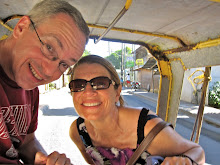 It is the mid-Autumn festival here, a major holidays on the traditional Chinese calendar. Also known as the Moon Festival or the Mooncake festival, it is celebrated throughout east Asia, including Japan, Korea, Viet Nam, and Malyasia.
It is the mid-Autumn festival here, a major holidays on the traditional Chinese calendar. Also known as the Moon Festival or the Mooncake festival, it is celebrated throughout east Asia, including Japan, Korea, Viet Nam, and Malyasia.And of course, here in Singapore.
The basis for the holiday is the Chinese legend of the "woman in the moon", Chang'e. There are several variations to the legend; all of them have her floating up to the moon from earth and being associated with a rabbit that lives on the moon. This is why the posters used in advertising all have her pictured with a rabbit. The 2007 moon probe launched by China was named Chang'e1, and the legend was referred to during radio exchanges during the Apollo 11 lunar mission.
Dating back over 3,000 years, this holiday has developed a wide range of common and regional traditions. The two most obvious (as in commercial) ones are mooncakes and pomelos. You can find both on sale all over the city and in wide ranges of quality and price points.
 Pomelos are the largest citrus fruit (can be 2x larger than a 16" Chicago softball). Very moon-like.
Pomelos are the largest citrus fruit (can be 2x larger than a 16" Chicago softball). Very moon-like.Mooncakes are the more ubiquitous. They are everwhere: huge road shows in shopping malls, sidewalk booths, at hotels, and specialized bakeries. We recently went on a seasonal tour of Chinatown, which is - as you would expect - mooncake central in Singapore. We got to sample several varieties and tour one of the bakeries.
 Mooncakes have a skin of phyllo like pastery which is either brown or white (snow skin). The filling is traditionally lotus seed paste and has one or more egg yolks baked inside - the yolks representing the moon. More yolks are better (and of course more expensive). Other fillings are used: sweet bean paste or mashed dates. There are also modern adaptations, the most intriguing is a local Haagen Dasz one that uses dark chocolate as the crust, vanilla ice cream instead of the lotus seed paste, and a round dollop of mango sorbet in lieu of the egg yolk.
Mooncakes have a skin of phyllo like pastery which is either brown or white (snow skin). The filling is traditionally lotus seed paste and has one or more egg yolks baked inside - the yolks representing the moon. More yolks are better (and of course more expensive). Other fillings are used: sweet bean paste or mashed dates. There are also modern adaptations, the most intriguing is a local Haagen Dasz one that uses dark chocolate as the crust, vanilla ice cream instead of the lotus seed paste, and a round dollop of mango sorbet in lieu of the egg yolk.
How do they taste? Well... different. They are very rich and heavy; a serving is a small slice. Raye is not a fan; Paul likes some of them. We both wondered if these are the cultural equivalent of fruitcakes: the gift that keeps on giving, so to speak. Apparently not. It's traditional to sit outside under the full moon and eat mooncake together as a family.
 Mooncakes are not to be confused with moonpies: Mooncake is traditionally served with tea. Moonpie is traditionally accompanied by RC Cola.
Mooncakes are not to be confused with moonpies: Mooncake is traditionally served with tea. Moonpie is traditionally accompanied by RC Cola.Maybe next year, we'll import some moonpies and RC - just for variety.

1 comment:
http://www.entrepreneur.com/startingabusiness/successstories/article197044.html
Post a Comment